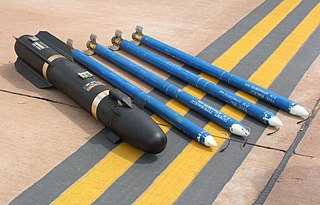
The Hydra 70 rocket is a 2.75-inch (70 mm) diameter fin-stabilized unguided rocket used primarily in the air-to-ground role. It can be equipped with a variety of warheads, and in more recent versions, guidance systems for point attacks. The Hydra is widely used by US and allied forces, competing with the Canadian CRV-7, with which it is physically interchangeable.

The Jupiter-C was an American research and development vehicle developed from the Jupiter-A. Jupiter-C was used for three sub-orbital spaceflights in 1956 and 1957 to test re-entry nosecones that were later to be deployed on the more advanced PGM-19 Jupiter mobile missile.
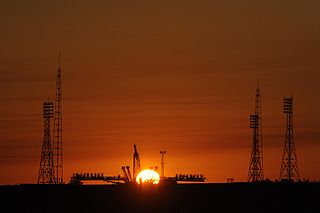
The Baikonur Cosmodrome is a spaceport located in an area of southern Kazakhstan leased to Russia.

Plesetsk Cosmodrome is a Russian spaceport located in Mirny, Arkhangelsk Oblast, about 800 km north of Moscow and approximately 200 km south of Arkhangelsk, dates from 1957. Originally developed as an ICBM site for the R-7 missile, it also served for numerous satellite launches using the R-7 and other rockets. Its high latitude makes it useful only for certain types of launches, especially the Molniya orbits, so for much of the site's history it functioned as a secondary location, with most orbital launches taking place from Baikonur, in the Kazakh SSR. With the end of the Soviet Union, Baikonur became foreign territory, and Kazakhstan charged $115 million usage fees annually. Consequently, Plesetsk has seen considerably more activity since the 2000s.

The Aerobee rocket was a small unguided suborbital sounding rocket used for high atmospheric and cosmic radiation research in the United States in the 1950s.

Delta is an American versatile family of expendable launch systems that has provided space launch capability in the United States since 1960. More than 300 Delta rockets have been launched with a 95% success rate. Only the Delta IV Heavy rocket remains in use as of August 22, 2019. Delta rockets are currently manufactured and launched by the United Launch Alliance.

The Black Brant is a family of Canadian-designed sounding rockets originally built by Bristol Aerospace, since absorbed by Magellan Aerospace in Winnipeg, Manitoba. Over 800 Black Brants of various versions have been launched since they were first produced in 1961, and the type remains one of the most popular sounding rockets ever built. They have been repeatedly used by the Canadian Space Agency and NASA.

The PGM-19 Jupiter was the first nuclear tipped, medium-range ballistic missile (MRBM) of the United States Air Force (USAF). It was a liquid-propellant rocket using RP-1 fuel and LOX oxidizer, with a single Rocketdyne LR79-NA rocket engine producing 667 kN of thrust. It was armed with the 1.44 megaton W49 nuclear warhead. The prime contractor was the Chrysler Corporation.
The Nike-Cajun was a two-stage sounding rocket built by combining a Nike base stage with a Cajun upper stage. It was launched 714 times between 1956 and 1976 and was the most frequently used sounding rocket of the western world. The Nike Cajun had a launch weight of 698 kg (1538 lb), a payload of 23 kg (51 lb), a launch thrust of 246 kN (55,300 lbf) and a maximum altitude of 120 km (394,000 ft). It had a diameter of 42 cm and a length of 7.70 m. The maximum speed of the Nike-Cajun was 6,760 km/h (4,200 mph).

The Geosynchronous Satellite Launch Vehicle Mark III, also referred to as the Launch Vehicle Mark 3 (LVM3) is a three-stage medium-lift launch vehicle developed by the Indian Space Research Organisation (ISRO). Primarily designed to launch communication satellites into geostationary orbit, it is also identified as launch vehicle for crewed missions under the Indian Human Spaceflight Programme and dedicated science missions like Chandrayaan-2. The GSLV-III has a higher payload capacity than the similarly named GSLV Mk 2.

The Weishi family of the multiple rocket launcher systems were mainly developed by Sichuan Aerospace Industry Corporation in Chengdu, Sichuan Province. The Weishi series rocket systems include the 302 mm WS-1, the improved 302 mm WS-1B, the 122 mm WS-1E (40 km), the 400 mm WS-2, as well as many other models. The WS-1 series weapon system did not enter PLA service and has order from Thailand. The WS-2 may finally see PLA service in the future. It's worth noticing that although sharing the same name, there are other developers for different models of Weishi series multiple rocket launchers (MRL) other than the primary developer SCAIC.
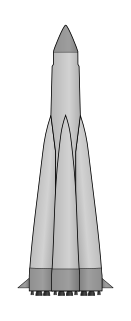
The Polyot was an interim orbital carrier rocket, built to test ASAT spacecraft. It was required as a stopgap after the cancellation of the UR-200 programme, but before the Tsyklon could enter service. Only two were ever launched, the first on 1 November 1963, and the last on 12 April 1964. Both of these flights were successful.
The A-100 is a 300 mm, 10-tube multiple rocket launcher developed by Beijing-based China Academy of Launch Vehicle Technology for the Chinese PLA ground forces. It is a derivative of Weishi Rockets WS-1 with simple cascade terminal inertial guidance.

Saturn V was an American human-rated super heavy-lift launch vehicle used by NASA between 1967 and 1973. The three-stage liquid-propellant expendable rocket was developed to support the Apollo program for human exploration of the Moon and was later used to launch Skylab, the first American space station.
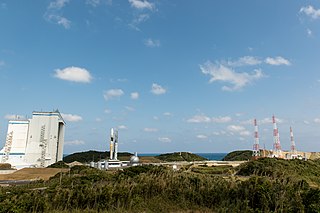
The Yoshinobu Launch Complex, also known as Launch Area Y, Area Y or LA-Y, is a launch complex at the Tanegashima Space Centre, located on Tanegashima, the Japanese island located 115 km south of Kyūshū. The complex is used for the H-II and H-IIA carrier rockets. The complex is also used by the H-IIB, which was first launched on 10 September 2009. That flight launched the HTV-1 spacecraft to resupply the International Space Station.
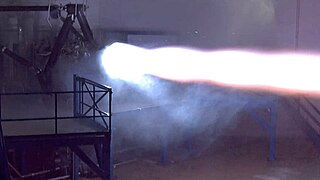
Raptor is a staged combustion, methane-fueled rocket engine manufactured by SpaceX. The engine is powered by cryogenic liquid methane and liquid oxygen (LOX), rather than the RP-1 kerosene and LOX used in SpaceX's prior Merlin and Kestrel rocket engine families. The earliest concepts for Raptor considered liquid hydrogen as fuel rather than methane. The Raptor engine has about two times the thrust of the Merlin 1D engine that powers the current Falcon 9 launch vehicle.

Rohini is a series of sounding rockets developed by the Indian Space Research Organisation (ISRO) for meteorological and atmospheric study. These sounding rockets are capable of carrying payloads of 2 to 200 kilograms between altitudes of 100 to 500 kilometres. The ISRO currently uses RH-200, RH-300, RH-300 Mk-II and RH-560 Mk-II rockets, which are launched from the Thumba Equatorial Rocket Launching Station (TERLS) in Thumba and the Satish Dhawan Space Center in Sriharikota.
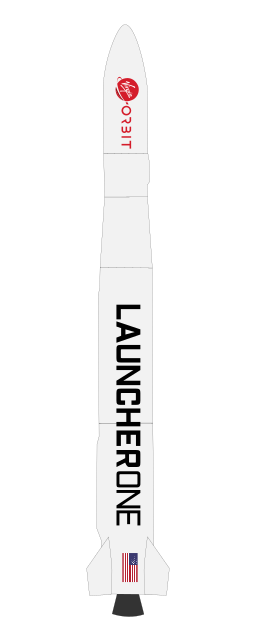
LauncherOne is a two stage orbital launch vehicle under development by Virgin Orbit since 2007. It is an air launch to orbit rocket, designed to launch "smallsat" payloads of 300 kilograms (660 lb) into Sun-synchronous orbit, following air launch from a carrier aircraft at high altitude. Launches are projected to begin in 2019.
Kuaizhou is a family of Chinese "quick-reaction" orbital launch vehicles. Flying since 2013, Kuaizhou 1 and 1A consist of three solid-fueled rocket stages, with a liquid-fueled fourth stage as part of the satellite system. Kuaizhou 11, introduced in 2018, is a larger model able to launch a 1,500-kilogram (3,300 lb) payload into low Earth orbit. Heavy-lift models KZ-21 and KZ-31 are in development. The Kuaizhou series of rockets is manufactured by ExPace, a subsidiary of China Aerospace Science and Industry Corporation (CASIC), as their commercial launch vehicles.
The KN-09 (K-SS-X-9) is a North Korean 300 mm rocket artillery system of a launcher unit comprising 8 rockets packaged in two four-rocket pods.


















